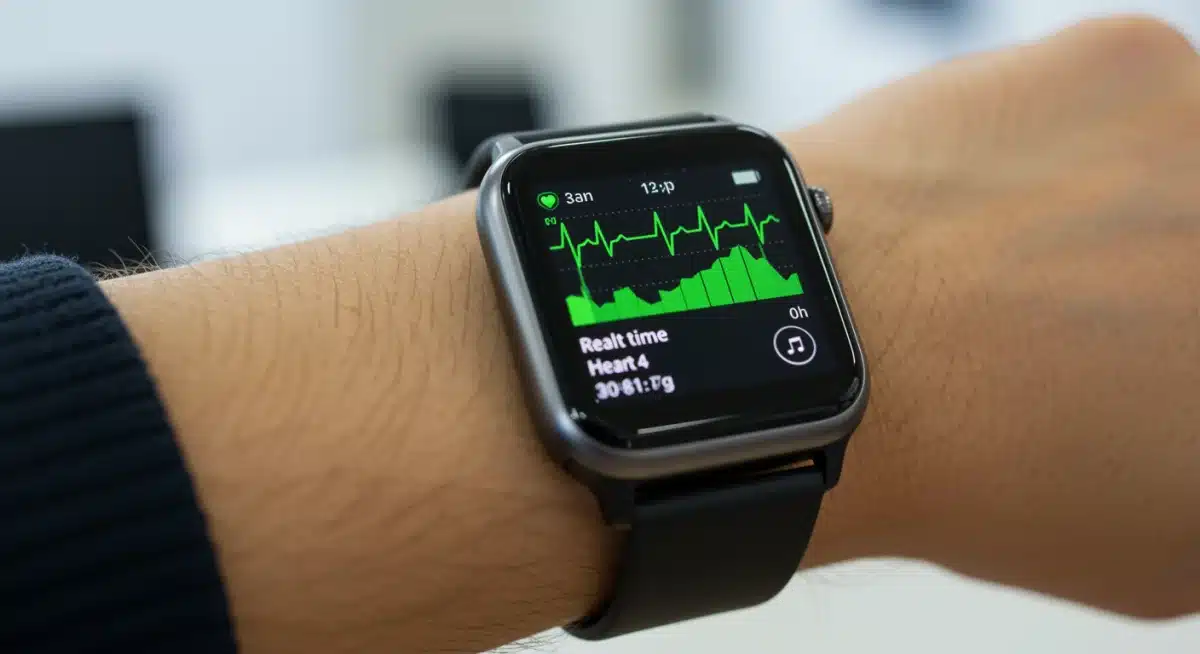Wearable Tech for Health: 5 Key Metrics for US Wellness in 2025
Wearable technology offers US users an unparalleled opportunity to proactively manage their health by tracking essential metrics, providing actionable insights for improved well-being in 2025.
The landscape of personal health management is undergoing a profound transformation, driven largely by advancements in wearable technology. For US users, understanding how to leverage these innovative devices to track crucial health metrics is no longer a luxury but a fundamental step towards proactive wellness. This article delves into wearable tech for health: 4 insider insights on how US users can track 5 key metrics for better wellness in 2025, offering a roadmap to optimizing your well-being through data-driven decisions.
The rise of wearable health technology
Wearable health technology has moved beyond simple step counting to become sophisticated tools that offer a comprehensive view of our physiological state. These devices, ranging from smartwatches and fitness trackers to smart rings and patches, are increasingly integrated into daily life, providing continuous monitoring and personalized feedback. Their accessibility and ease of use have made them indispensable for millions of Americans seeking to take control of their health.
The evolution of wearable tech is characterized by enhanced sensor accuracy, longer battery life, and more intuitive user interfaces. What began as niche gadgets for fitness enthusiasts has blossomed into mainstream health companions, capable of detecting early signs of health issues and promoting healthier habits. This shift is particularly significant in the US, where there’s a growing emphasis on preventative care and individual responsibility for wellness.
From fitness fad to medical utility
Initially perceived as mere fitness accessories, wearables have matured into credible health monitoring devices. Regulatory bodies like the FDA are increasingly recognizing their potential, with some devices even receiving clearance for medical-grade functions. This evolution underscores their growing importance in both consumer health and clinical settings, bridging the gap between personal wellness and professional medical care.
- Early detection: Wearables can alert users to potential health anomalies like irregular heart rhythms.
- Chronic disease management: They assist in monitoring conditions such as diabetes and hypertension.
- Personalized insights: Data collected provides tailored recommendations for exercise, sleep, and stress reduction.
Integration with healthcare systems
The future of wearable tech lies in its seamless integration with broader healthcare ecosystems. Imagine your doctor having real-time access to your heart rate variability or sleep patterns, allowing for more informed diagnoses and treatment plans. This level of data sharing, while raising privacy concerns, promises a revolution in personalized medicine, making healthcare more proactive and patient-centric.
As technology advances, so too does the potential for these devices to become integral components of health records and telehealth services. The ability to passively collect vast amounts of physiological data transforms episodic healthcare into continuous health management, empowering individuals and healthcare providers alike with unprecedented insights.
Key metric 1: heart rate variability (HRV)
Heart Rate Variability (HRV) is rapidly gaining recognition as a critical metric for overall health and well-being. Unlike a simple heart rate measurement, HRV assesses the variation in time between your heartbeats. A higher HRV generally indicates a more adaptable and resilient nervous system, while a lower HRV can signal stress, overtraining, or potential health issues. For US users, understanding and tracking HRV offers a powerful tool for managing stress and optimizing recovery.
Many modern wearables now include advanced sensors capable of accurately measuring HRV, providing users with daily insights into their body’s readiness. This data can inform decisions about exercise intensity, stress management techniques, and even sleep quality, promoting a more holistic approach to health. Regularly monitoring HRV can help individuals identify patterns and make proactive adjustments to their lifestyle.
Understanding your body’s resilience
HRV serves as a window into your autonomic nervous system, reflecting the balance between its sympathetic (fight or flight) and parasympathetic (rest and digest) branches. A high HRV suggests a well-balanced system, indicating that your body is better equipped to handle stress and recover efficiently. Conversely, a consistently low HRV can be a warning sign that your body is under chronic stress or overexertion, necessitating a closer look at your lifestyle.
By understanding what your personal HRV baseline looks like, you can begin to interpret daily fluctuations. For example, a significant drop in HRV after a particularly stressful day or an intense workout might signal the need for more rest and recovery. This personalized feedback empowers users to make smarter choices about their daily activities and overall well-being.
Practical applications for US users
- Stress management: Identify periods of high stress and implement relaxation techniques.
- Optimizing training: Adjust workout intensity based on recovery status to prevent overtraining.
- Sleep quality assessment: Observe how sleep impacts HRV and make necessary improvements.
- Early illness detection: A sudden, sustained drop in HRV can sometimes precede the onset of illness.
The ability to track HRV provides a nuanced understanding of internal physiological responses that traditional metrics might miss. It allows for a more personalized approach to health, moving beyond generic advice to data-driven strategies tailored to each individual’s unique biological rhythms.
Key metric 2: sleep stages and quality
Sleep is a cornerstone of good health, yet its importance is often underestimated. Wearable technology has revolutionized our ability to monitor not just the duration of sleep, but also its quality and the different stages we cycle through. For US users, gaining insights into REM, deep, and light sleep stages can unlock profound improvements in cognitive function, physical recovery, and emotional regulation. Poor sleep impacts everything from productivity to immune function, making accurate tracking invaluable.
Advanced wearables use accelerometers and heart rate sensors to estimate sleep stages with increasing accuracy. They can identify sleep disturbances, provide sleep scores, and offer personalized recommendations to improve sleep hygiene. This data empowers individuals to understand their unique sleep patterns and make informed adjustments to their routines.
Decoding your nocturnal cycles
Each sleep stage plays a vital role in our overall health. Deep sleep is crucial for physical restoration and growth hormone release, while REM sleep is essential for memory consolidation and emotional processing. Light sleep acts as a transition stage. Understanding the proportion of time spent in each stage can reveal underlying issues that impact daytime performance and long-term health.
For instance, consistently low amounts of deep sleep might indicate a need to optimize your sleep environment or reduce evening caffeine intake. Similarly, insufficient REM sleep could point to stress or irregular sleep schedules. Wearable devices provide the data needed to pinpoint these areas for improvement, transforming guesswork into actionable insights.
Improving sleep hygiene with data
- Identify disturbances: Pinpoint factors like restless sleep or frequent awakenings.
- Optimize bedtime routine: Understand how evening habits affect sleep onset and quality.
- Track trends: Observe how lifestyle changes (e.g., exercise, diet) impact sleep over time.
- Personalized recommendations: Receive tips on ideal sleep duration and environmental adjustments.
The detailed feedback from wearables goes beyond simply telling you how long you slept; it provides a comprehensive picture of your sleep architecture. This detailed understanding allows US users to implement targeted strategies, from adjusting room temperature to practicing mindfulness, all aimed at achieving more restorative sleep and, consequently, better overall health.
Key metric 3: stress levels via EDA and heart rate
Chronic stress is a pervasive issue in modern life, significantly impacting both physical and mental health. Fortunately, wearable technology is becoming increasingly adept at quantifying stress levels, offering US users a proactive way to manage this silent epidemic. Devices now utilize metrics like Electrodermal Activity (EDA), also known as skin conductance, alongside heart rate data, to provide real-time indicators of physiological stress.
EDA sensors detect minute changes in sweat gland activity, which are directly correlated with sympathetic nervous system activation – our body’s stress response. Combined with heart rate and HRV data, these readings paint a comprehensive picture of your body’s stress load throughout the day. This innovative approach allows for timely interventions, helping individuals mitigate the adverse effects of stress before they escalate.

The science behind stress detection
When you experience stress, your body releases hormones like cortisol and adrenaline, triggering physiological responses such as increased heart rate, elevated blood pressure, and changes in skin conductivity. Wearables capture these subtle shifts, translating complex biological signals into understandable stress scores or zones. This objective measurement helps individuals move beyond subjective feelings of stress to a data-backed understanding of their body’s state.
By continuously monitoring these metrics, devices can identify patterns and triggers for stress, enabling users to develop more effective coping mechanisms. Whether it’s a stressful meeting, a challenging workout, or simply an overwhelming day, the data provides clarity, allowing for more targeted interventions like breathing exercises or short breaks.
Actionable insights for daily life
- Real-time alerts: Receive notifications when stress levels are elevated.
- Guided breathing exercises: Access in-app tools to help calm the nervous system.
- Identify stress triggers: Understand what situations or activities lead to increased stress.
- Track recovery: Monitor how effectively you de-stress and recover from stressful events.
Integrating stress monitoring into daily life via wearables offers a powerful feedback loop. It empowers US users to not only recognize stress but also to actively manage it, fostering greater emotional resilience and promoting overall mental well-being. This proactive approach to stress management is a game-changer for maintaining a balanced and healthy lifestyle.
Key metric 4: skin temperature trends
While often overlooked, skin temperature trends are emerging as a valuable health metric trackable by wearable devices. Unlike core body temperature, which remains relatively stable, skin temperature can fluctuate in response to various internal and external factors, offering insights into sleep quality, illness onset, and even menstrual cycles for women. For US users, monitoring these subtle shifts provides an additional layer of personal health awareness.
Many advanced smartwatches and fitness trackers now incorporate highly sensitive temperature sensors. These devices typically establish a personal baseline temperature and then track deviations from it, rather than providing an absolute temperature reading. This trend-based approach is particularly useful for identifying subtle physiological changes that might otherwise go unnoticed.
Beyond the fever: what skin temperature reveals
A persistent elevation in baseline skin temperature could indicate an impending illness or an inflammatory response in the body, often before other symptoms manifest. Conversely, consistent lower temperatures might point to issues with circulation or metabolic rate. For women, daily skin temperature tracking can be instrumental in identifying ovulation patterns, aiding in family planning.
The power of this metric lies in its continuous, passive measurement. Instead of relying on periodic thermometer checks, wearables provide a constant stream of data, allowing for the detection of subtle shifts over time. This longitudinal data can be incredibly insightful for understanding individual health patterns and making proactive health decisions.
Practical applications and future potential
- Early illness detection: Noticeable deviations from baseline can signal an upcoming cold or infection.
- Sleep environment optimization: Understand how room temperature affects your nocturnal skin temperature and sleep quality.
- Menstrual cycle tracking: Aid in fertility awareness and understanding hormonal fluctuations.
- Recovery monitoring: Observe how intense workouts or stress impact your body’s temperature regulation.
As wearable technology continues to advance, the accuracy and utility of skin temperature tracking will only improve. This metric, combined with other physiological data, offers a more comprehensive and personalized view of health, empowering US users to respond to their body’s signals with greater precision and foresight.
Key metric 5: blood oxygen saturation (SpO2)
Blood oxygen saturation, or SpO2, is a crucial indicator of respiratory and circulatory health. It measures the percentage of hemoglobin in your red blood cells that is carrying oxygen. For US users, maintaining optimal SpO2 levels is vital for energy, cognitive function, and overall well-being. Wearable devices equipped with pulse oximeters now make it easy to monitor this metric, particularly during sleep or at high altitudes.
While not a diagnostic tool, continuous SpO2 monitoring can provide valuable insights into potential breathing issues, especially during sleep. A consistent drop in blood oxygen levels during the night could indicate sleep apnea or other respiratory challenges, prompting individuals to seek medical advice. This passive monitoring capability adds a significant layer of health surveillance.

Understanding your body’s oxygen delivery
Oxygen is essential for every cell in your body to function correctly. Low SpO2 levels can lead to fatigue, shortness of breath, and impaired cognitive function. Wearables use light sensors to estimate blood oxygen levels, providing a non-invasive way to track this vital sign. Healthy individuals typically have SpO2 readings between 95% and 100%.
Monitoring SpO2 trends, especially during sleep, can help identify subtle changes in respiratory function. For example, if you notice consistent dips in your SpO2 during the night, it might be an indication to discuss it with a healthcare professional. This proactive approach can lead to earlier diagnosis and management of conditions that might otherwise go undetected.
Who benefits most from SpO2 tracking?
- Individuals with sleep concerns: Helps detect potential sleep apnea or other nocturnal breathing issues.
- Athletes: Monitors oxygen efficiency during training and at varying altitudes.
- High-altitude travelers: Ensures safe acclimatization to lower oxygen environments.
- General wellness enthusiasts: Provides an additional data point for comprehensive health monitoring.
The integration of SpO2 monitoring into everyday wearables empowers US users with a deeper understanding of their respiratory health. It transforms a previously clinical measurement into an accessible personal metric, enabling individuals to make more informed decisions about their lifestyle and seek medical attention when necessary, thus contributing to better overall wellness.
Insider insights for maximizing wearable data in 2025
Having access to an abundance of health data from wearables is only the first step; the real value lies in how US users interpret and act upon these insights. In 2025, maximizing the potential of wearable tech requires a blend of technological understanding, critical thinking, and a willingness to integrate data into daily habits. It’s about translating raw numbers into actionable strategies for better wellness.
One crucial insight is to avoid data overload. While wearables collect a lot of information, focus on the key metrics that are most relevant to your personal health goals. Another is to understand that correlation does not always equal causation; use the data as a guide for further investigation or consultation with healthcare professionals, rather than definitive diagnoses.
Insight 1: contextualize your data
Your wearable data is most meaningful when viewed within the context of your daily life. A spike in heart rate might be alarming out of context, but perfectly normal if you were just exercising or experiencing an exciting moment. Log your activities, diet, stress events, and feelings alongside your wearable data to create a richer, more accurate picture of your health trends.
- Journaling: Keep a digital or physical journal to correlate events with data fluctuations.
- Environmental factors: Consider how weather, altitude, or air quality might impact metrics.
- Personal events: Note significant life events or stressors that could influence your readings.
Insight 2: focus on trends, not daily fluctuations
Daily variations in metrics like HRV or sleep scores are normal. The true power of wearable data comes from identifying long-term trends. A single night of poor sleep isn’t a crisis, but a consistent pattern of insufficient deep sleep over weeks warrants attention. Look for sustained changes that indicate a shift in your health or lifestyle rather than reacting to every minor fluctuation.
This long-term perspective helps in understanding the effectiveness of new habits or interventions. Did increasing your daily walks improve your HRV over a month? Did adjusting your bedtime routine lead to more consistent deep sleep? Trends provide the answers, guiding sustainable changes for better wellness.
Insight 3: integrate with professional guidance
Wearable tech is a powerful tool for personal monitoring, but it is not a substitute for professional medical advice. Share your wearable data with your doctor or a certified health coach. They can help interpret complex patterns, provide clinical context, and guide you toward appropriate medical interventions or lifestyle modifications. This collaborative approach ensures that your data leads to genuinely effective health outcomes.
Many wearable platforms now offer features for secure data sharing with healthcare providers, streamlining the process. This integration closes the loop between self-monitoring and professional care, making the data even more impactful in managing and improving your health.
Insight 4: prioritize consistency and patience
The most valuable insights from wearable tech come from consistent use over time. Sporadic tracking will yield fragmented and less reliable data. Make wearing your device a daily habit, and be patient with the results. Lifestyle changes take time to manifest in physiological data, and understanding your body’s unique rhythms requires a sustained effort. Consistency is key to unlocking the full potential of wearable tech for your health journey.
| Key Metric | Brief Description |
|---|---|
| Heart Rate Variability (HRV) | Measures heart rhythm variations, indicating stress resilience and recovery. |
| Sleep Stages & Quality | Analyzes time in REM, deep, and light sleep for restorative rest insights. |
| Stress Levels (EDA/HR) | Quantifies physiological stress using skin conductance and heart rate data. |
| Blood Oxygen (SpO2) | Monitors oxygen saturation in blood, crucial for respiratory health. |
Frequently Asked Questions about Wearable Health Tech
The accuracy of wearable devices varies by metric and manufacturer. While generally good for trends and personal insights, they are not medical-grade diagnostic tools. For critical health decisions, always consult a healthcare professional. Continuous advancements are steadily improving their precision.
Some wearables are FDA-cleared for specific medical functions, like detecting atrial fibrillation. However, most are for wellness tracking and can only flag potential anomalies. They are excellent for early warning signs, prompting users to seek professional medical evaluation rather than self-diagnose.
Privacy is a significant concern. Users should carefully review privacy policies of wearable manufacturers and associated apps. Ensure data is encrypted, stored securely, and not shared without explicit consent. Opt for devices and platforms with strong data protection practices.
Consider your primary health goals: do you prioritize sleep, fitness, stress management, or a combination? Research device features, battery life, comfort, and ecosystem compatibility (e.g., Apple Health, Google Fit). Read reviews and compare specific metric tracking capabilities for optimal choice.
Generally, consumer wearable devices are not directly covered by health insurance. However, some wellness programs or employer benefits might offer subsidies or incentives. Certain medical-grade wearables prescribed by a doctor for specific conditions might be eligible for reimbursement, but this varies greatly by plan.
Conclusion
As we navigate 2025, wearable technology stands as an indispensable ally in the pursuit of better health and wellness for US users. By offering unprecedented access to critical physiological data, from Heart Rate Variability and detailed sleep stages to real-time stress levels, skin temperature trends, and blood oxygen saturation, these devices empower individuals to move beyond reactive healthcare to a truly proactive approach. The ability to track, understand, and act upon these five key metrics, guided by the four insider insights presented, transforms abstract health goals into tangible, data-driven achievements. Embracing wearable tech means embracing a future where personal wellness is continuously monitored, deeply understood, and actively managed, fostering a healthier, more resilient population across the United States.





